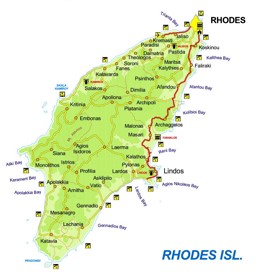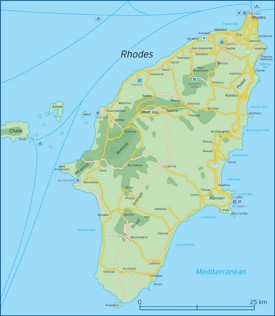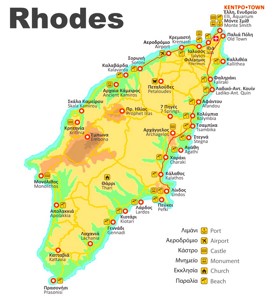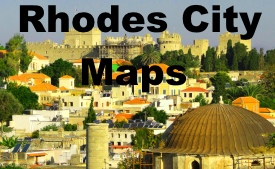Rhodes Maps
Online Map of Rhodes
About Rhodes
Rhodes is the largest of the Dodecanese islands and the fourth-largest Greek island overall, located in the southeastern Aegean Sea near the Turkish coast. The island covers 541 square miles and has a population of approximately 120,000 residents. Rhodes Town, the capital and largest city, is located on the northern tip and is divided into the medieval Old Town and the modern New Town. The island serves as the administrative center of the Dodecanese island group.
The Medieval City of Rhodes, the Old Town, is one of the best-preserved medieval towns in Europe and a UNESCO World Heritage Site. Surrounded by massive walls built and reinforced by the Knights of St. John (Knights Hospitaller) who ruled Rhodes from 1309 to 1522, the fortified city features cobblestone streets, Gothic architecture, and numerous monuments. The Palace of the Grand Master, originally built in the 14th century and restored during Italian occupation, dominates the highest point of the Old Town. The Street of the Knights (Ippoton), one of the best-preserved medieval streets in Europe, features Gothic buildings that housed the tongues (national divisions) of the Knights.
Ancient Rhodes, located near the modern town, was one of antiquity's most important cities. While the Colossus of Rhodes, one of the Seven Wonders of the Ancient World, no longer exists (having collapsed in an earthquake in 226 BCE), the ancient city has left significant remains. The Archaeological Museum, housed in the former Hospital of the Knights, contains finds from throughout the Dodecanese. The ancient Acropolis of Lindos, located 31 miles south on the east coast, sits atop a steep cliff 380 feet above the sea. The site includes a Doric Temple of Athena Lindia, a Hellenistic stoa, and Byzantine fortifications, with the medieval village of Lindos below featuring distinctive white houses with decorated courtyards.
The west coast town of Ialyssos (Trianda) and the site of ancient Kamiros on the northwest coast preserve remains of two of Rhodes' three ancient city-states that united to form Rhodes city in 408 BCE. The interior features the Valley of the Butterflies (Petaloudes), a nature reserve where thousands of Jersey Tiger moths gather during summer. The mountain villages of the interior, including Siana, Embona near Mount Attavyros (the island's highest peak at 3,986 feet), and Kritinia, preserve traditional architecture and customs.
Italian rule (1912-1943) left significant architectural legacy beyond the restoration work in Rhodes Town, including Art Deco and rationalist buildings. The east coast is generally more developed for tourism with numerous resort areas, including Faliraki, while the west coast is more exposed to winds and has rougher seas. The southern part of the island, including the town of Kattavia, remains less developed. Rhodes International Airport "Diagoras" is one of Greece's busiest, serving extensive international connections. The economy is heavily based on tourism, though agriculture (particularly wine production) and some industry also contribute. Rhodes maintains ferry connections throughout the Dodecanese, to Crete, the Cyclades, and Piraeus. The island's combination of ancient history, medieval heritage, beaches, and developed infrastructure makes it one of Greece's most popular destinations.
The Facts:Region: South Aegean.
Regional unit: Rhodes.
Cities, towns, and villages: Rhodes City, Ialysos, Afantou, Archangelos, Kremasti, Kalythies, Koskinou, Pastida, Paradeisi, Maritsa, Embonas, Soroni, Lardos, Psinthos, Malona, Lindos, Apollona, Massari, Fanes, Theologos, Archipoli, Asklipio, Gennadi, Salakos, Kritinia, Kattavia, Dimylia, Kalavarda, Pylona, Istrios, Damatria, Laerma, Apolakkia, Platania, Kalathos, Lachania, Monolithos, Mesanagros, Profilia, Arnitha, Siana, Vati, Agios Isidoros.
Population: ~ 120,000.
Area: 541 sq mi (1,401 sq km).
Maps of Greece
Cities of Greece
Greek Islands
Peninsulas of Greece






